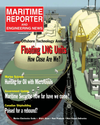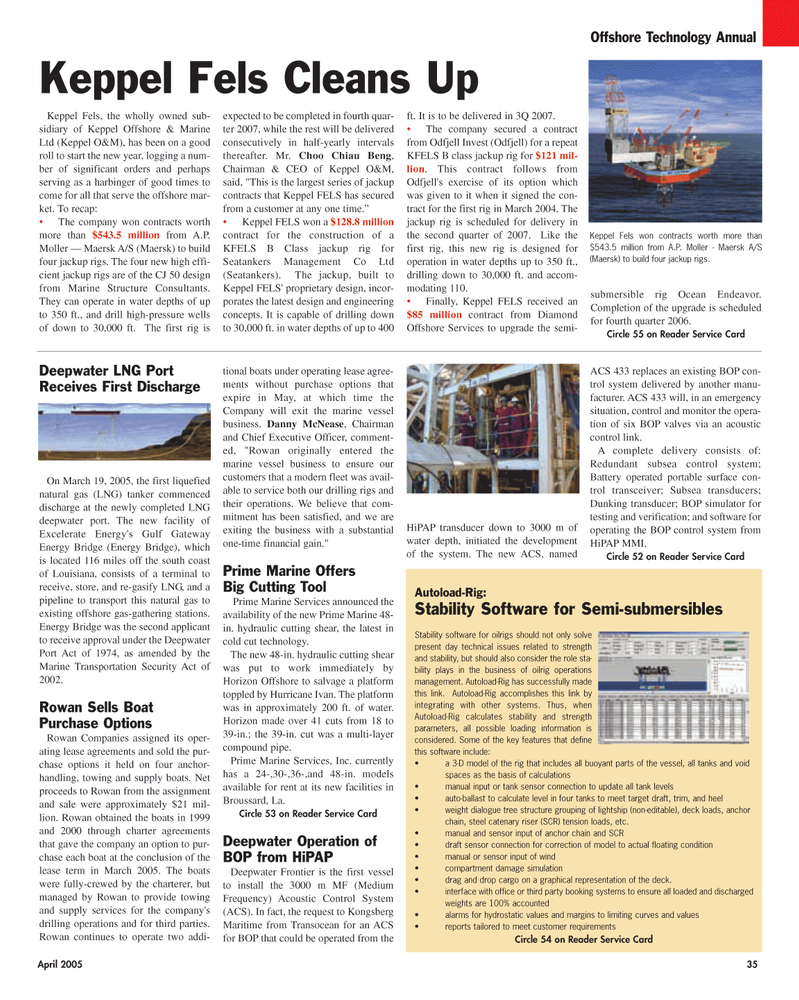
Page 35: of Maritime Reporter Magazine (April 2005)
The Offshore Industry Anual
Read this page in Pdf, Flash or Html5 edition of April 2005 Maritime Reporter Magazine
Deepwater LNG Port
Receives First Discharge
On March 19, 2005, the first liquefied natural gas (LNG) tanker commenced discharge at the newly completed LNG deepwater port. The new facility of
Excelerate Energy's Gulf Gateway
Energy Bridge (Energy Bridge), which is located 116 miles off the south coast of Louisiana, consists of a terminal to receive, store, and re-gasify LNG, and a pipeline to transport this natural gas to existing offshore gas-gathering stations.
Energy Bridge was the second applicant to receive approval under the Deepwater
Port Act of 1974, as amended by the
Marine Transportation Security Act of 2002.
Rowan Sells Boat
Purchase Options
Rowan Companies assigned its oper- ating lease agreements and sold the pur- chase options it held on four anchor- handling, towing and supply boats. Net proceeds to Rowan from the assignment and sale were approximately $21 mil- lion. Rowan obtained the boats in 1999 and 2000 through charter agreements that gave the company an option to pur- chase each boat at the conclusion of the lease term in March 2005. The boats were fully-crewed by the charterer, but managed by Rowan to provide towing and supply services for the company's drilling operations and for third parties.
Rowan continues to operate two addi- tional boats under operating lease agree- ments without purchase options that expire in May, at which time the
Company will exit the marine vessel business. Danny McNease, Chairman and Chief Executive Officer, comment- ed, "Rowan originally entered the marine vessel business to ensure our customers that a modern fleet was avail- able to service both our drilling rigs and their operations. We believe that com- mitment has been satisfied, and we are exiting the business with a substantial one-time financial gain."
Prime Marine Offers
Big Cutting Tool
Prime Marine Services announced the availability of the new Prime Marine 48- in. hydraulic cutting shear, the latest in cold cut technology.
The new 48-in. hydraulic cutting shear was put to work immediately by
Horizon Offshore to salvage a platform toppled by Hurricane Ivan. The platform was in approximately 200 ft. of water.
Horizon made over 41 cuts from 18 to 39-in.; the 39-in. cut was a multi-layer compound pipe.
Prime Marine Services, Inc. currently has a 24-,30-,36-,and 48-in. models available for rent at its new facilities in
Broussard, La.
Circle 53 on Reader Service Card
Deepwater Operation of
BOP from HiPAP
Deepwater Frontier is the first vessel to install the 3000 m MF (Medium
Frequency) Acoustic Control System (ACS). In fact, the request to Kongsberg
Maritime from Transocean for an ACS for BOP that could be operated from the
HiPAP transducer down to 3000 m of water depth, initiated the development of the system. The new ACS, named
ACS 433 replaces an existing BOP con- trol system delivered by another manu- facturer. ACS 433 will, in an emergency situation, control and monitor the opera- tion of six BOP valves via an acoustic control link.
A complete delivery consists of:
Redundant subsea control system;
Battery operated portable surface con- trol transceiver; Subsea transducers;
Dunking transducer; BOP simulator for testing and verification; and software for operating the BOP control system from
HiPAP MMI.
Circle 52 on Reader Service Card
Keppel Fels, the wholly owned sub- sidiary of Keppel Offshore & Marine
Ltd (Keppel O&M), has been on a good roll to start the new year, logging a num- ber of significant orders and perhaps serving as a harbinger of good times to come for all that serve the offshore mar- ket. To recap: • The company won contracts worth more than $543.5 million from A.P.
Moller — Maersk A/S (Maersk) to build four jackup rigs. The four new high effi- cient jackup rigs are of the CJ 50 design from Marine Structure Consultants.
They can operate in water depths of up to 350 ft., and drill high-pressure wells of down to 30,000 ft. The first rig is expected to be completed in fourth quar- ter 2007, while the rest will be delivered consecutively in half-yearly intervals thereafter. Mr. Choo Chiau Beng,
Chairman & CEO of Keppel O&M, said, "This is the largest series of jackup contracts that Keppel FELS has secured from a customer at any one time.” Keppel FELS won a $128.8 million contract for the construction of a
KFELS B Class jackup rig for
Seatankers Management Co Ltd (Seatankers). The jackup, built to
Keppel FELS' proprietary design, incor- porates the latest design and engineering concepts. It is capable of drilling down to 30,000 ft. in water depths of up to 400 ft. It is to be delivered in 3Q 2007. The company secured a contract from Odfjell Invest (Odfjell) for a repeat
KFELS B class jackup rig for $121 mil- lion. This contract follows from
Odfjell's exercise of its option which was given to it when it signed the con- tract for the first rig in March 2004. The jackup rig is scheduled for delivery in the second quarter of 2007. Like the first rig, this new rig is designed for operation in water depths up to 350 ft., drilling down to 30,000 ft. and accom- modating 110. Finally, Keppel FELS received an $85 million contract from Diamond
Offshore Services to upgrade the semi- submersible rig Ocean Endeavor.
Completion of the upgrade is scheduled for fourth quarter 2006.
Circle 55 on Reader Service Card
Offshore Technology Annual
Autoload-Rig:
Stability Software for Semi-submersibles
Stability software for oilrigs should not only solve present day technical issues related to strength and stability, but should also consider the role sta- bility plays in the business of oilrig operations management. Autoload-Rig has successfully made this link. Autoload-Rig accomplishes this link by integrating with other systems. Thus, when
Autoload-Rig calculates stability and strength parameters, all possible loading information is considered. Some of the key features that define this software include: • a 3-D model of the rig that includes all buoyant parts of the vessel, all tanks and void spaces as the basis of calculations manual input or tank sensor connection to update all tank levels auto-ballast to calculate level in four tanks to meet target draft, trim, and heel weight dialogue tree structure grouping of lightship (non-editable), deck loads, anchor chain, steel catenary riser (SCR) tension loads, etc. manual and sensor input of anchor chain and SCR draft sensor connection for correction of model to actual floating condition manual or sensor input of wind compartment damage simulation drag and drop cargo on a graphical representation of the deck. interface with office or third party booking systems to ensure all loaded and discharged weights are 100% accounted alarms for hydrostatic values and margins to limiting curves and values reports tailored to meet customer requirements
Circle 54 on Reader Service Card
April 2005 35
Keppel Fels Cleans Up
Keppel Fels won contracts worth more than $543.5 million from A.P. Moller - Maersk A/S (Maersk) to build four jackup rigs.
MR APRIL 2005 #5 (33-40).qxd 4/4/2005 3:24 PM Page 3

 34
34

 36
36
